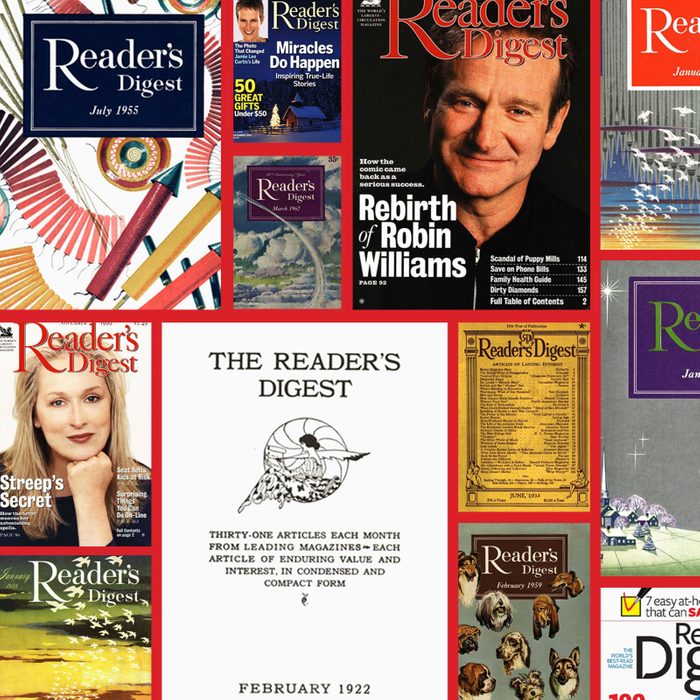
A century of Reader’s Digest covers
They say you can’t judge a book by its cover. But for many years, Reader’s Digest was an exception, often printing a full list of its contents on the cover for subscribers’ and newsstand browsers’ convenience. In honor of our 100th anniversary in 2022, we went through the magazine’s archives to collect these 60 memorable Reader’s Digest covers from the 20th and early 21st century. See how many you and your family can recognize.
For a sample of what was inside some of those issues, check out our other 100th anniversary articles, including the 100 funniest jokes from the last 100 years, the 100 funniest quotes from the past 100 years, 100 of the most uplifting quotes ever, and many more.
February 1922
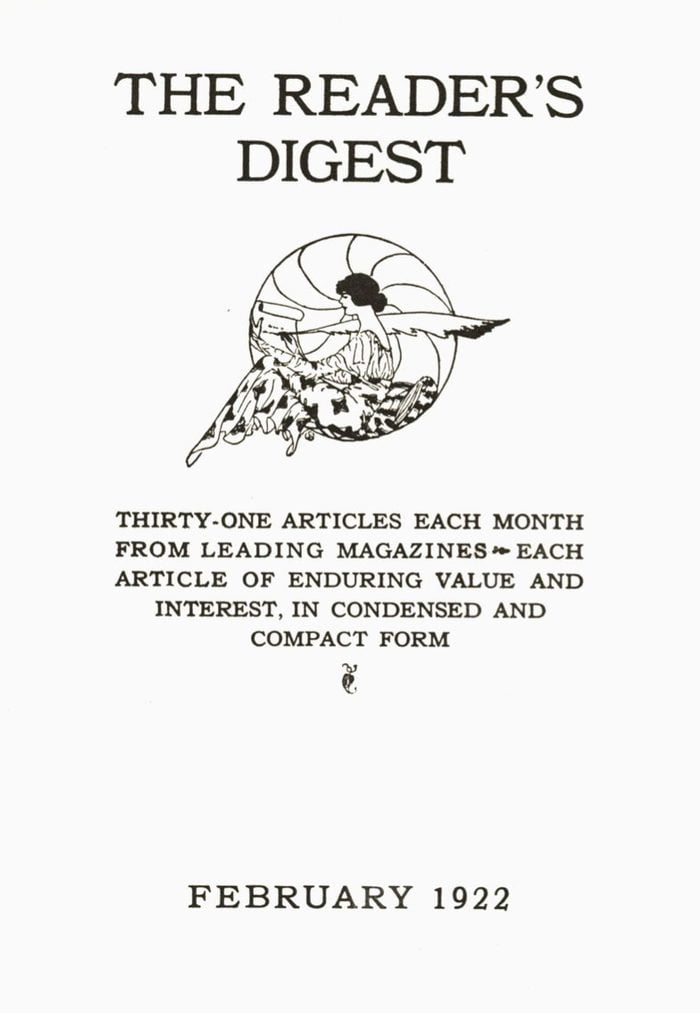
The first issue of Reader’s Digest appeared in February 1922. Newlyweds DeWitt and Lila Acheson Wallace, the magazine’s cofounders, mailed it to subscribers from their makeshift headquarters, a small rented room in the basement of a Greenwich Village speakeasy. They had borrowed enough money to pay a printer to run off 5,000 copies.
By the end of the 1920s, circulation exceeded 100,000, and it would one day top 17 million in the United States alone.
Reader’s Digest has now outlived most of the publications whose 31 articles the Wallaces condensed for their debut issue. Some happy exceptions are The Atlantic, Good Housekeeping, Popular Science, and Scientific American, which live on in print and/or digital form.
June 1933
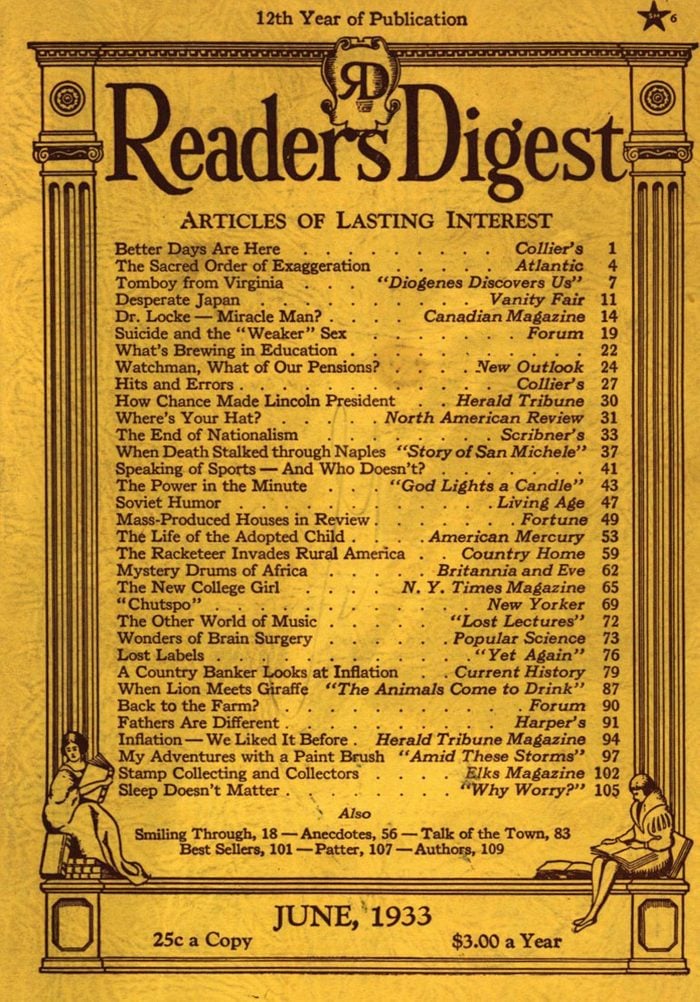
Starting in 1922 and for decades thereafter, Reader’s Digest printed its table of contents on the front cover. To distinguish each new issue from the previous month’s, early covers came in a rainbow of different colors. That continued into the 1940s. The example above dates back to 1933, generally considered the worst year of the Great Depression. Ever optimistic, the magazine chose as its lead article a reprint from Collier’s magazine titled “Better Days Are Here.”
July 1942

For its July 1942 issue, published seven months after the attack on Pearl Harbor and the United States’ entry into World War II, Reader’s Digest broke with tradition to put the American flag on its front cover. (In case readers wondered where the table of contents had gone, the magazine alerted them that they could find it on the back.) This cover was the magazine’s contribution to a nationwide patriotic effort called United We Stand, in which some 500 American magazines put the flag on their covers that month.
July 1943

With the war still raging, Reader’s Digest rolled out the flag again in July 1943.
July 1944
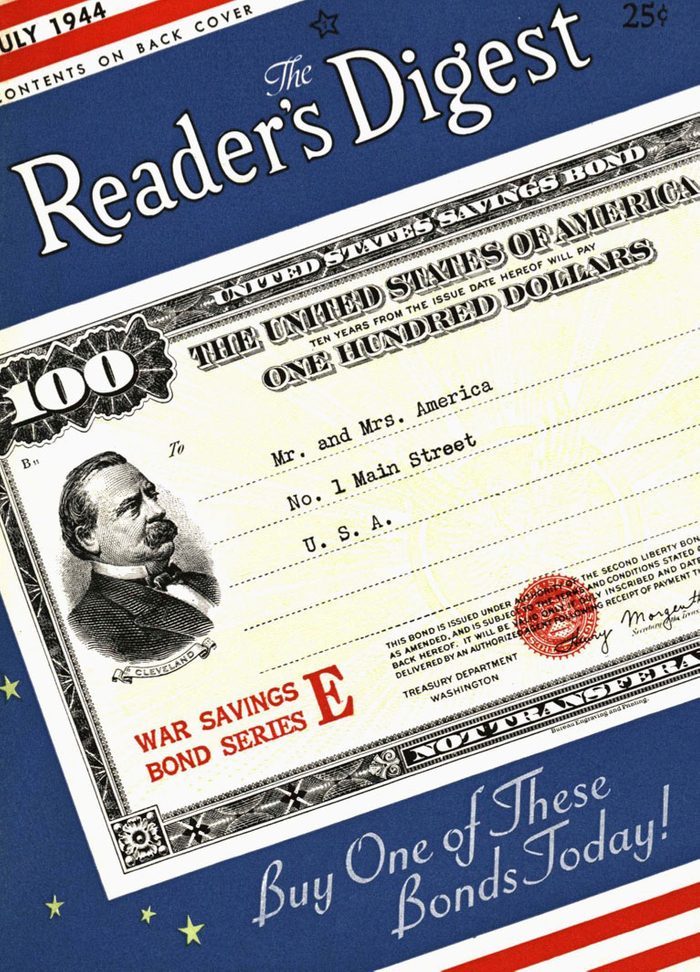
For its July 1944 cover, Reader’s Digest enlisted in the effort to sell war bonds.
October 1952
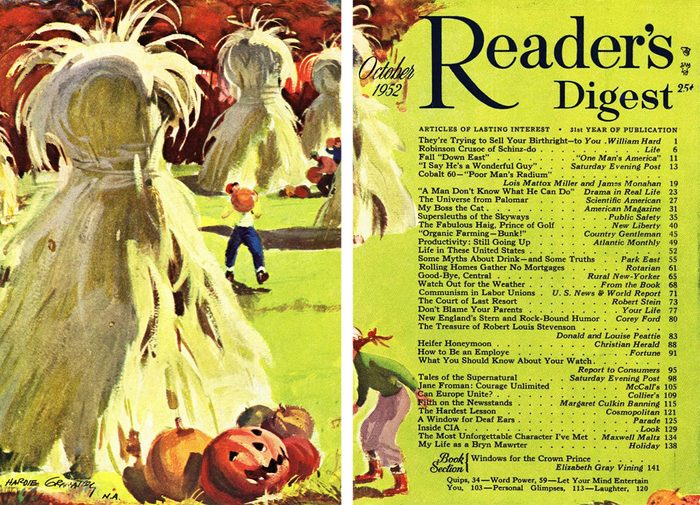
In the prosperous post-World War II era, Reader’s Digest‘s cover illustrations offered their own idealized image of Americans at work and play. From today’s perspective, these illustrations, like those found in many other magazines of the time, took little notice of the country’s racial diversity.
The front and back covers of the October 1952 issue typify the kinds of scenes subscribers of the 1950s and early 1960s saw when the latest issue of the magazine arrived in their mailboxes: wholesome and all-American (the magazine’s spine, not seen here, connected the two images).
December 1952
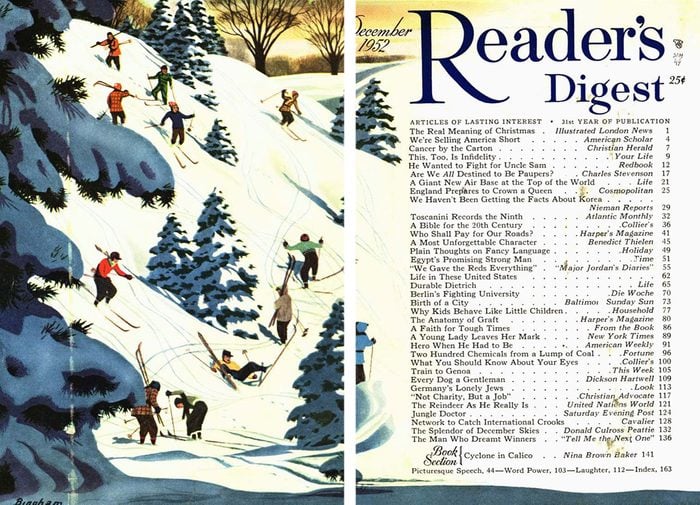
While much of this December 1952 issue contained light holiday fare, it also featured one of the magazine’s most influential anti-smoking articles, “Cancer by the Carton.” Its appearance in Reader’s Digest reportedly contributed to the largest decline in cigarette consumption since the Great Depression.
January 1953
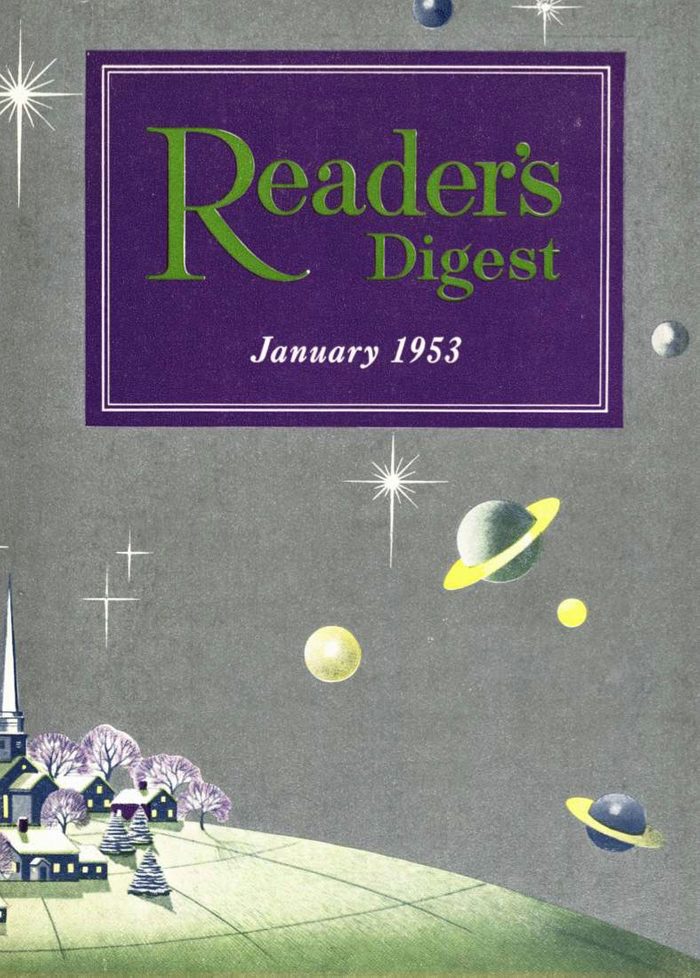
Best-selling author James A. Michener, a regular contributor to Reader’s Digest over several decades, gave readers an exclusive look at the war in Korea in this issue.
March 1953
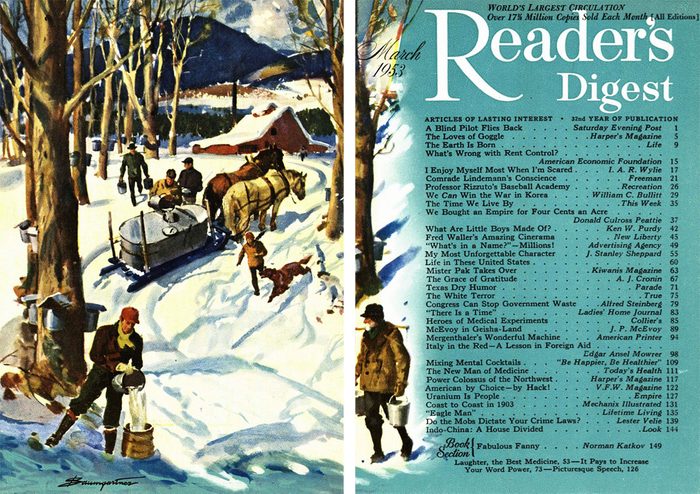
By early 1953, as this cover notes, Reader’s Digest had become the world’s largest-circulation magazine, selling more than 17.5 million copies each month through its U.S. and international editions.
October 1953
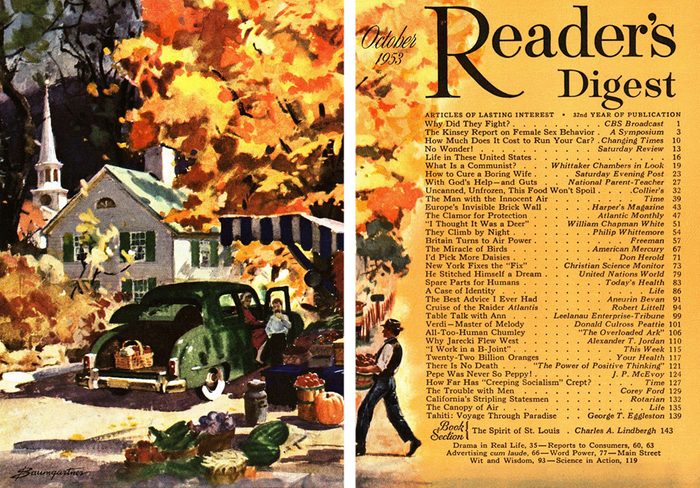
Each issue of Reader’s Digest included a special book section. In October 1953, aviator Charles A. Lindbergh recounted his legendary New York to Paris flight in the Spirit of St. Louis.
January 1955
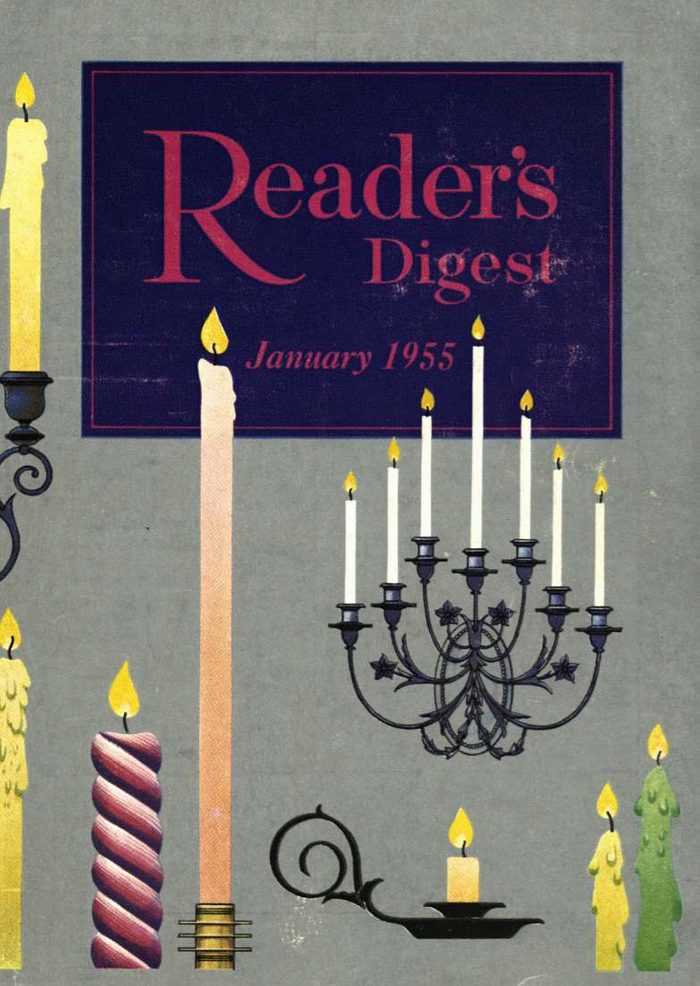
For its January issues, Reader’s Digest often moved the table of contents to the back cover. In 1955, the year this issue appeared, the magazine started accepting advertising for the first time. The coveted back cover remained off-limits to advertisers, however—a tradition that would continue for several more decades.
July 1955
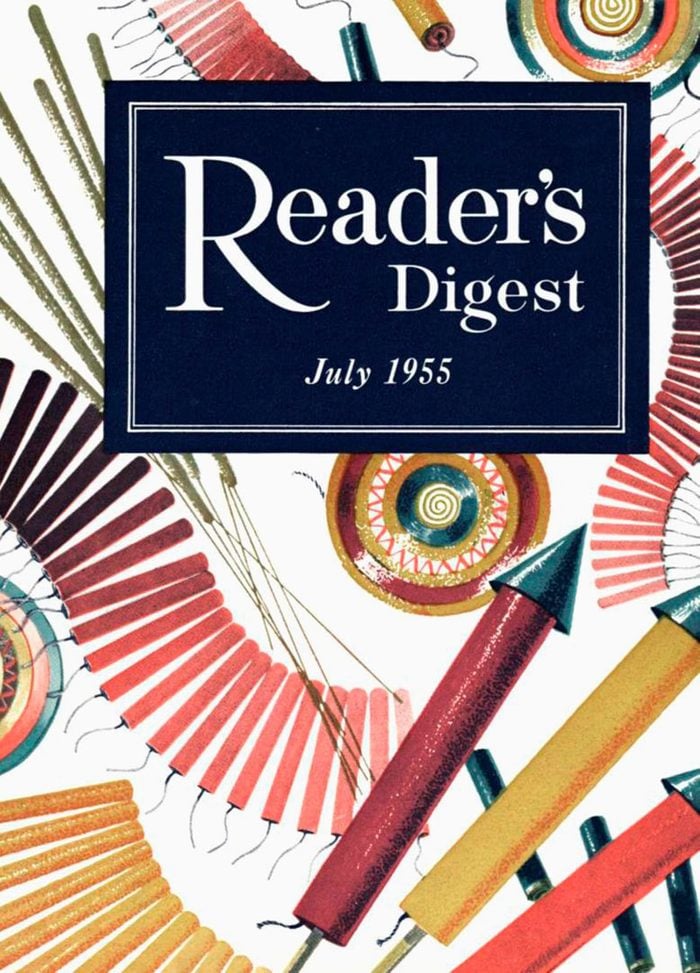
Reader’s Digest‘s July covers have often reflected a patriotic theme. Here’s a look at the history of the 4th of July and why we celebrate it.
January 1956
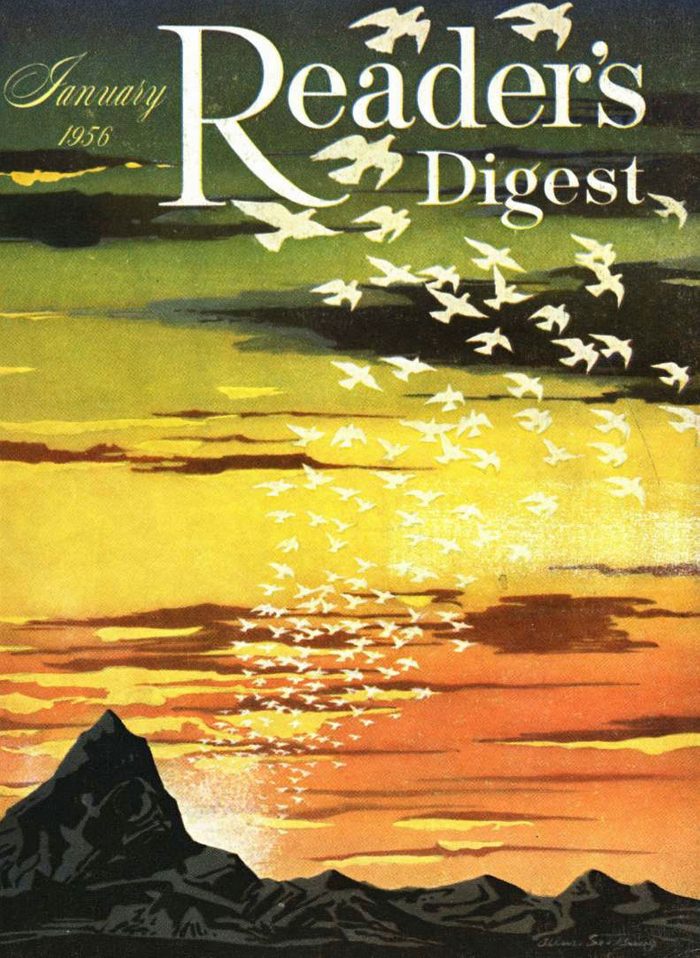
A Night to Remember, Walter Lord’s dramatic nonfiction book about the sinking of the Titanic, was the special book section in this 1956 issue. Even today there are Titanic mysteries that may never be solved.
July 1956

Reader’s Digest kept its readers current on the latest technology of the day. In this 1956 issue, the article “Elevators That Run by Themselves,” explained how computerized banks of elevators had eliminated the need for human operators.
September 1957
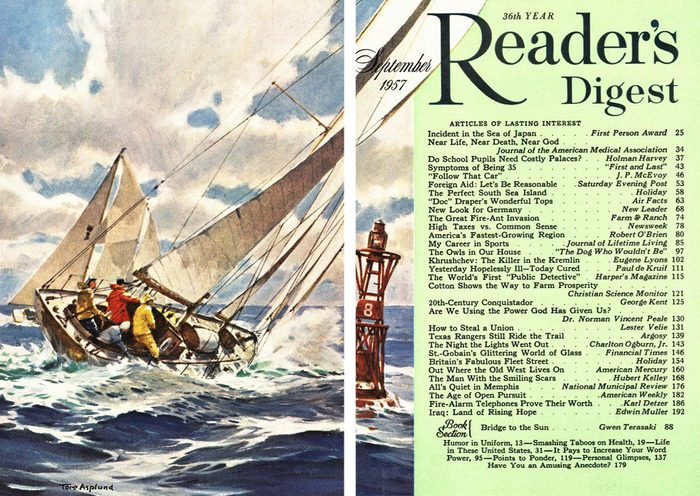
Dr. Norman Vincent Peale, author of The Power of Positive Thinking, brought his special brand of uplift to this and other issues of the magazine. Enjoy these good morning quotes to kick off a happy day.
April 1958
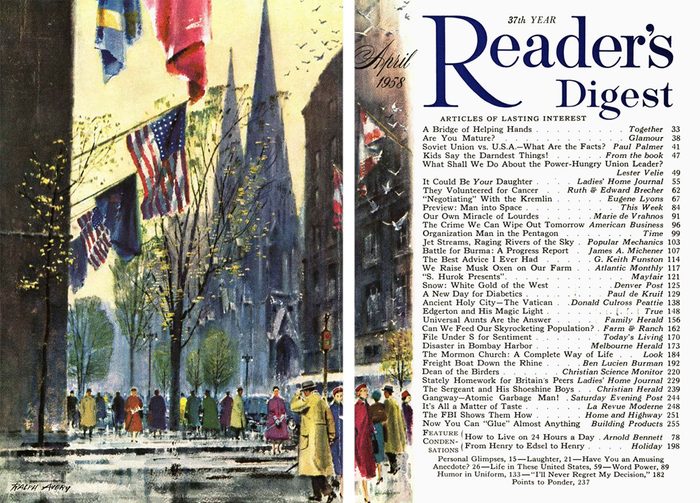
Reader’s Digest covers didn’t only feature rural or suburban settings, as this rainy-day city scene shows.
December 1958
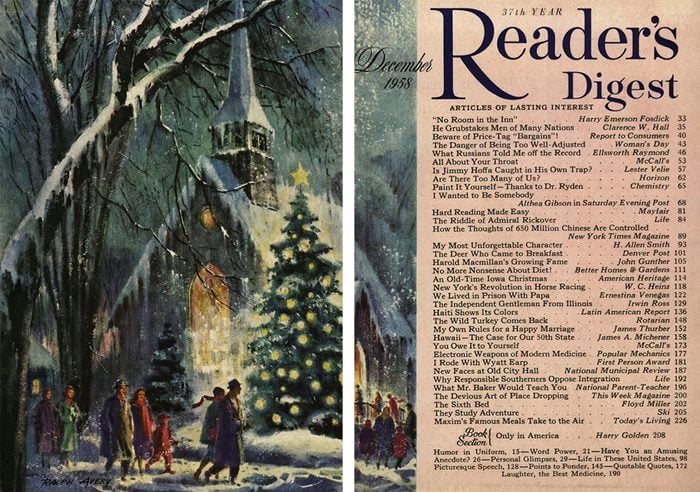
Author James A. Michener made the case for Hawaii’s statehood in this 1958 issue. The following year, it became the nation’s 50th state. In the mood for a trip to the islands? Check out the things to know before you book that Hawaiian vacation.
February 1959
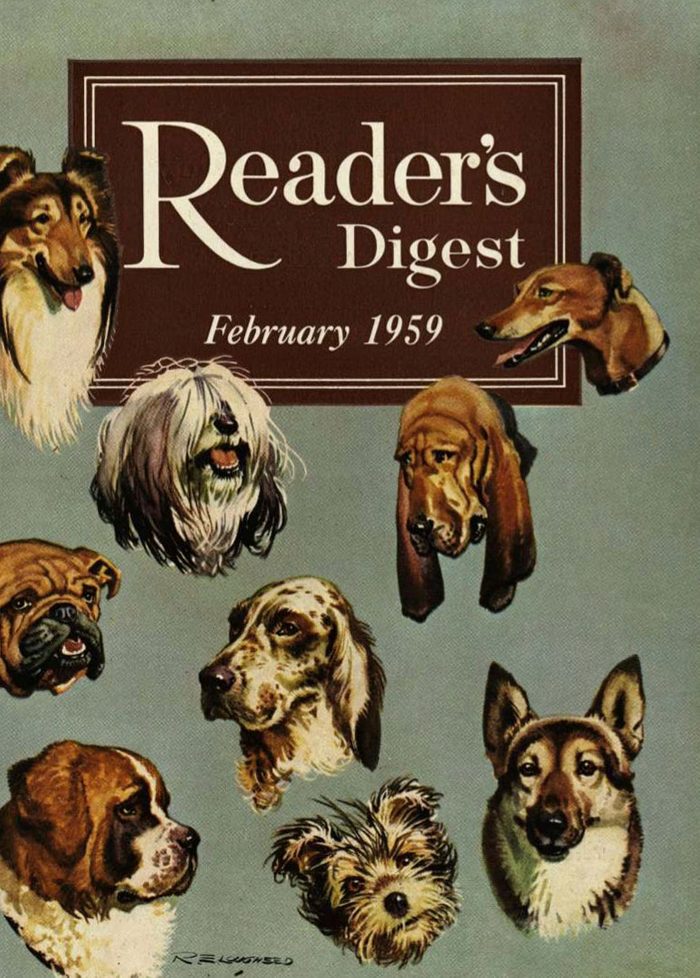
Dogs had their day on this 1959 cover. While we’re on the subject, here are some things your dog wishes you knew.
January 1960
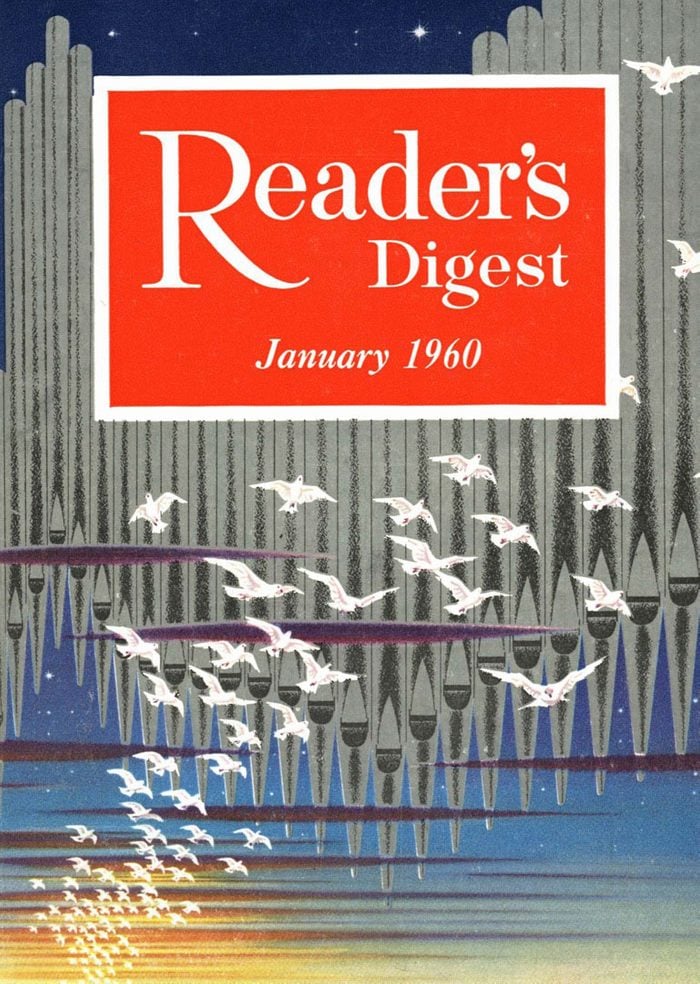
The conservation of America’s natural resources and wilderness areas was another cause embraced by Reader’s Digest. William Hard’s “Save a Spot for Beauty,” which ran in this issue, argued for preserving Thoreau’s Walden Pond and other landmarks and protecting them from developers.
April 1960
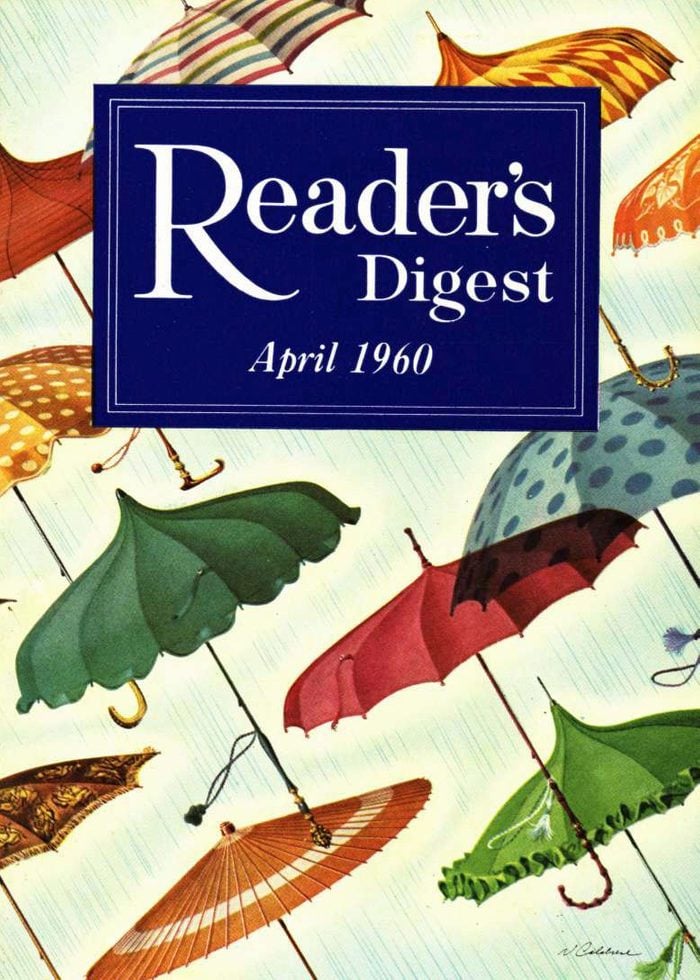
Come April each year, Reader’s Digest readers could often expect a subtle (or not-so-subtle) cover reference to April showers.
September 1960
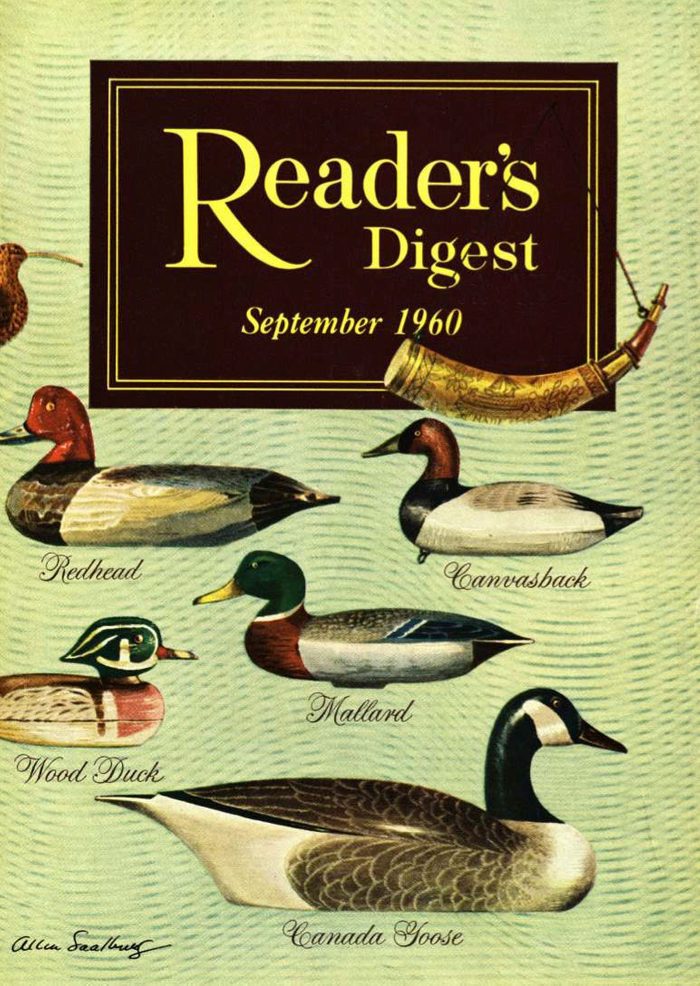
To accompany an article about home accidents, this issue contained a 28-page first-aid handbook that readers could pull out and save.
April 1961
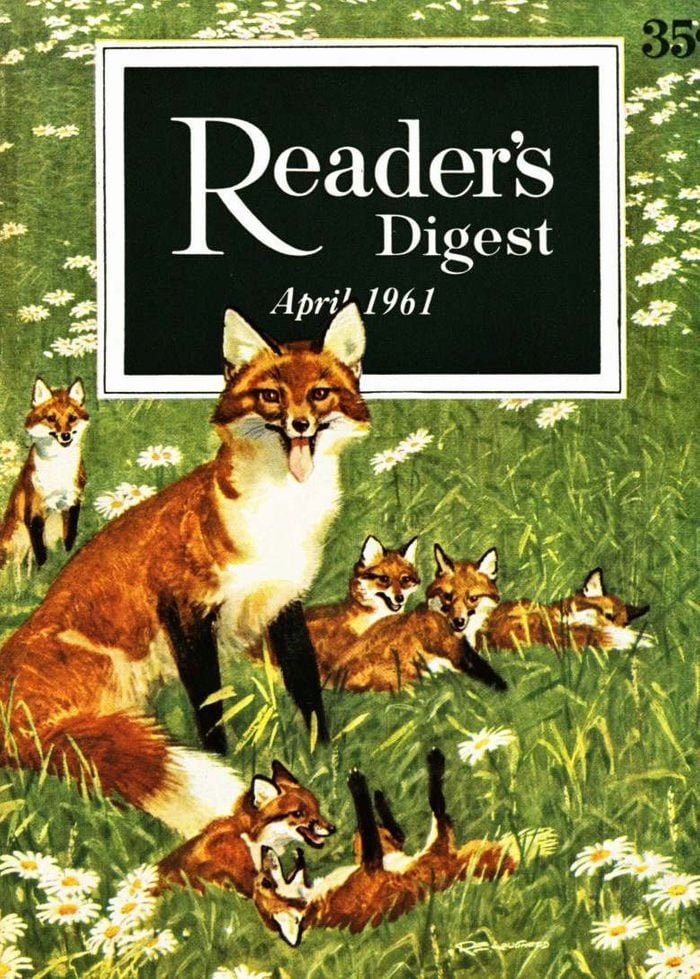
Although Reader’s Digest has rarely printed fiction, it made an exception in this issue for Ray Bradbury’s Civil War tale “The Drummer Boy of Shiloh.”
July 1961
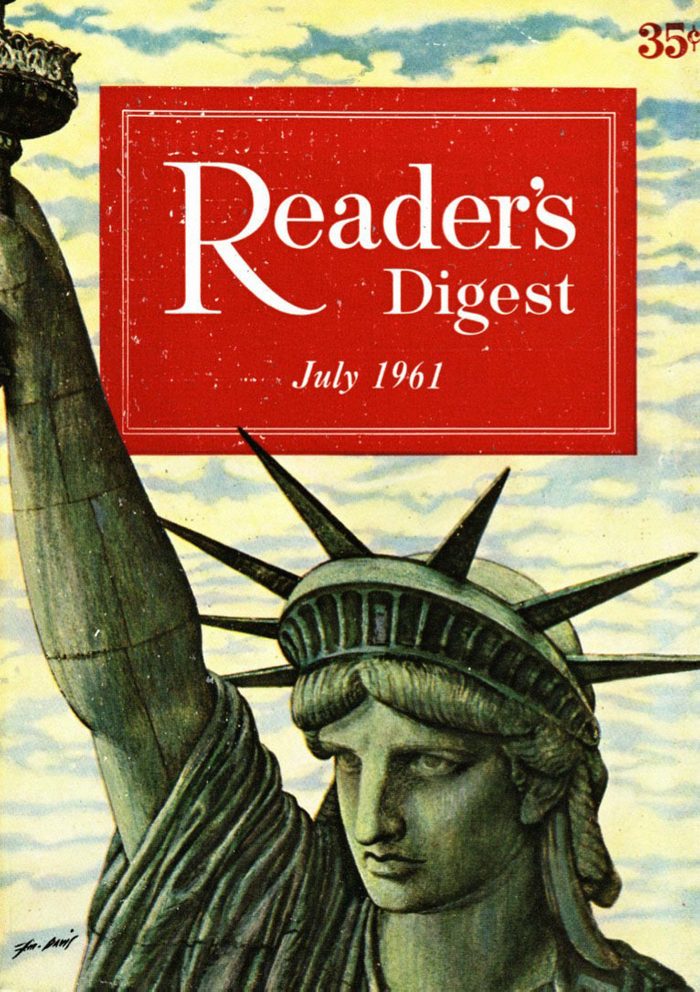
Lady Liberty got her close-up on this July cover. Here are some Statue of Liberty facts you probably didn’t know.
March 1962
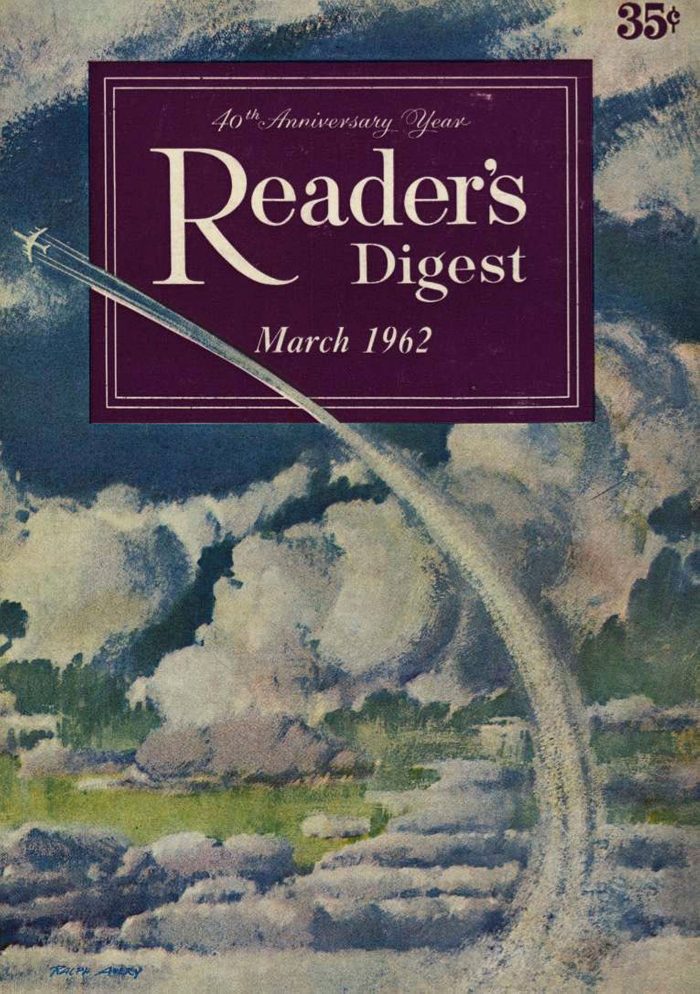
In 1962, Reader’s Digest celebrated its 40th anniversary with this cover salute to the new Jet Age.
October 1962
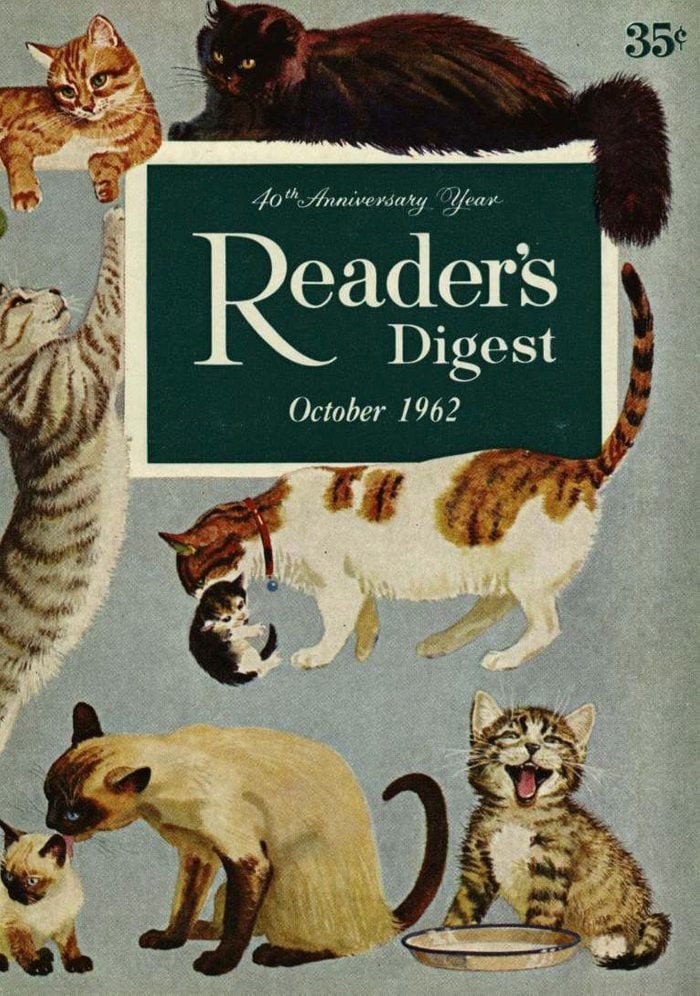
A few years after dogs had their day in the spotlight, cats became our cover stars. Speaking of which, here are some things your cat would love to tell you.
April 1964

April continued to shower on this 1964 cover. Inside, the magazine revisited two of its longtime causes: the dangers of cigarettes and the prevention of car crashes. Check out our latest advice on scary driving situations and how to handle them.
October 1964

The celebrated World War II general Douglas MacArthur contributed to this issue’s special book section.
November 1965
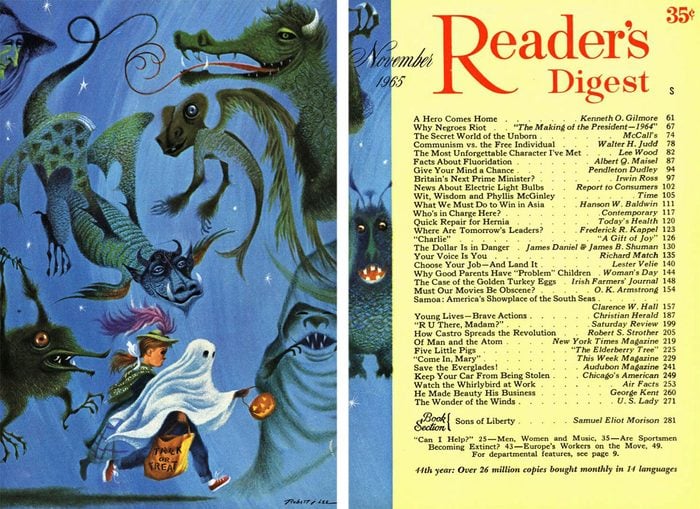
A pair of terrified trick-or-treaters and an assortment of fanciful monsters marked Halloween 1965 and ushered in the November chill.
May 1966
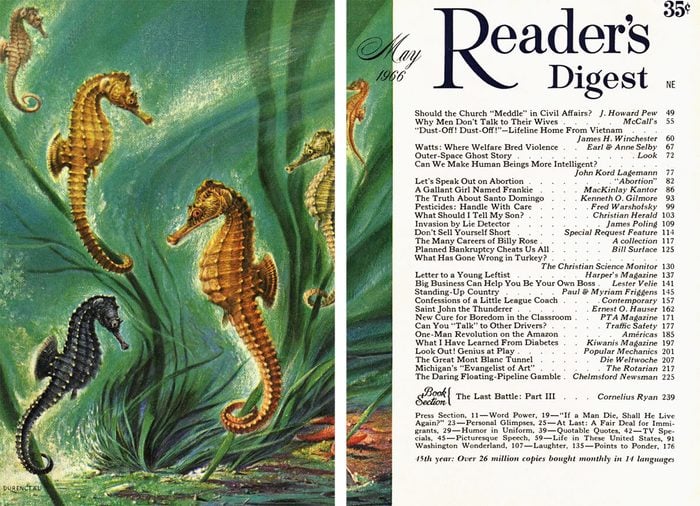
While many Americans remember the late 1960s and early 1970s as a turbulent era in the nation’s history, Reader’s Digest gave readers a break from the day’s headlines with soothing cover images that emphasized nature and patriotic themes.
October 1966

Novelist John Steinbeck tried to make sense of the ’60s in his essay “What’s Happening to America?” It was published in this 1966 issue.
November 1969
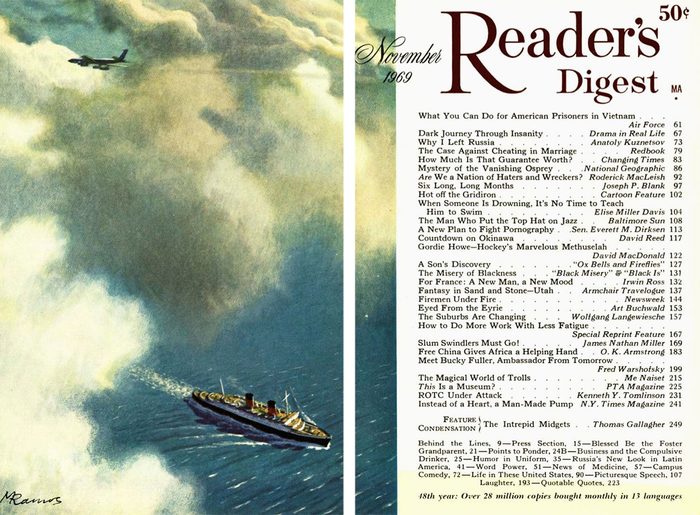
This 1969 cover offered a subtle commentary on the passing of the leisurely ocean liner era in favor of faster air travel.
July 1970
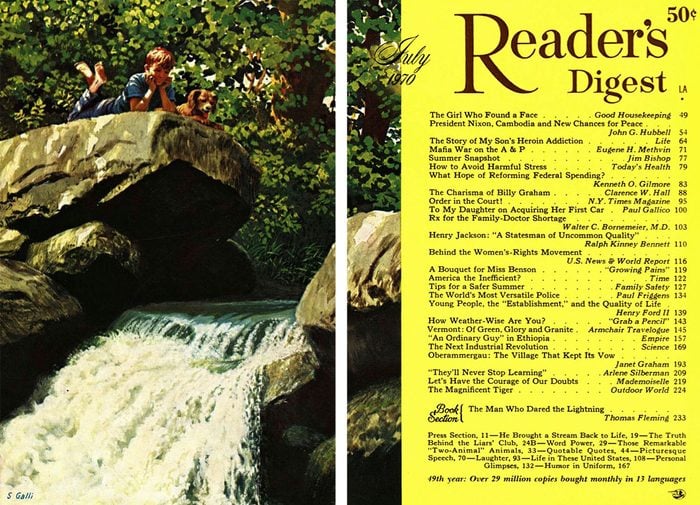
By 1970, Reader’s Digest was selling more than 29 million copies around the world each month and publishing in 13 languages.
December 1971
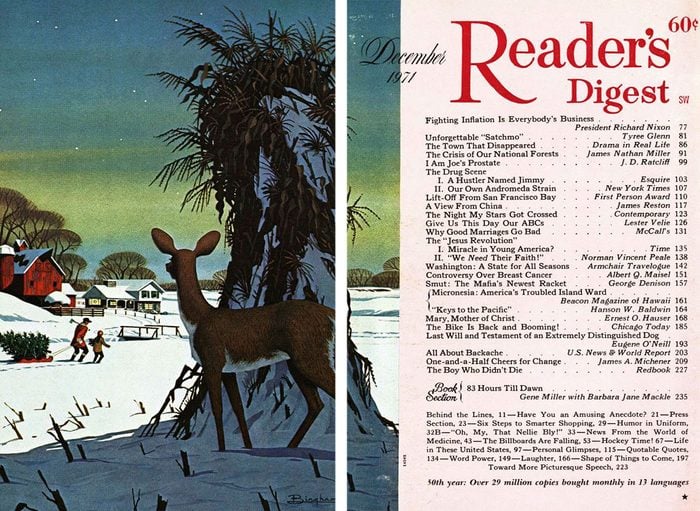
Then-president Richard Nixon led off this issue of the magazine with a call to arms against inflation. Can you guess who made our list of presidents with the highest IQ scores?
April 1972
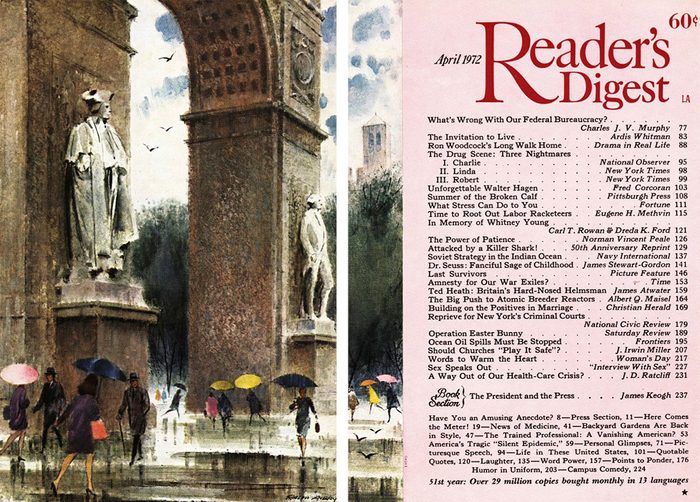
Dramatic first-person accounts became another Reader’s Digest trademark. This issue’s “Attacked by a Killer Shark!” by Rodney Fox was a classic example.
October 1974
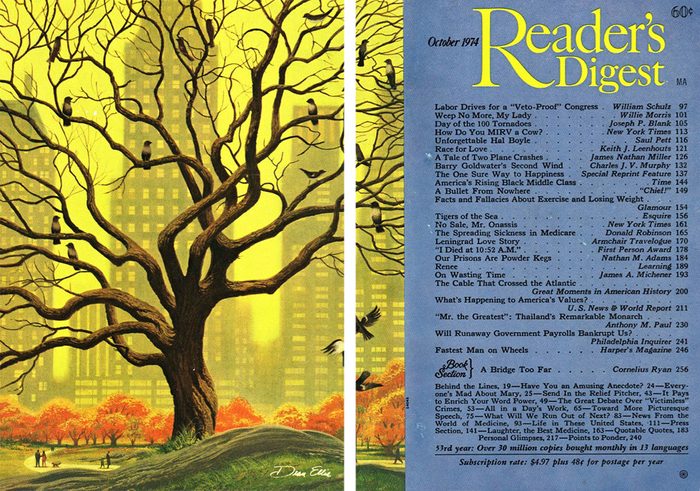
Cornelius Ryan’s classic World War II account, A Bridge Too Far, was this issue’s special book section. In 1959, Reader’s Digest had helped sponsor Ryan’s research for his celebrated chronicle of the D-Day invasion, The Longest Day, which later became a movie.
February 1984
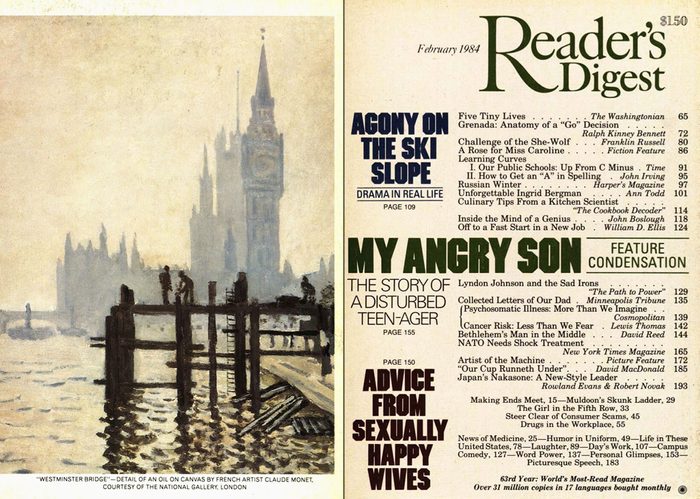
From the late 1970s into the 1990s, Reader’s Digest often treated its readers to works by some of the world’s great artists on its back covers, as the February 1984 issue, with a portion of a Claude Monet painting, shows. Perhaps not coincidentally, the magazine’s cofounder, Lila Acheson Wallace, was a major collector of fine art, and many of her pieces were displayed throughout the company’s Chappaqua, New York, headquarters. When a small portion of The Reader’s Digest Collection went up for auction in 1998, it sold for more than $86 million.
July 1985

A detail from Pierre Auguste Renoir’s “The Luncheon of the Boating Party” graces the back cover of the magazine.
May 1986
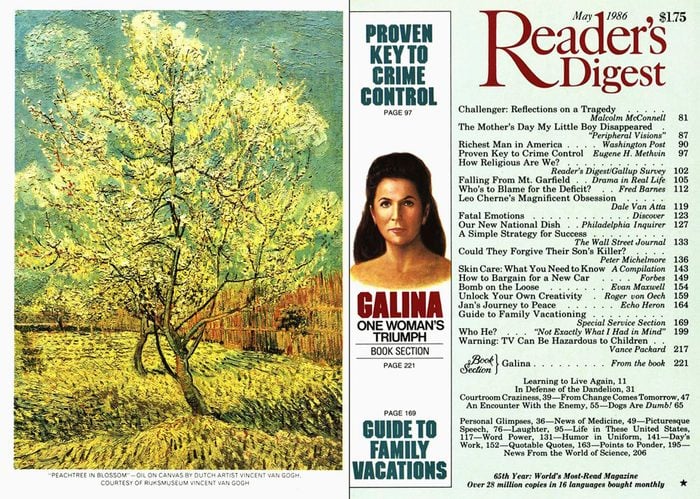
The 1986 cover of Reader’s Digest was all business in the front, but the back featured “Peachtree in Blossom” by Vincent van Gogh.
December 1986
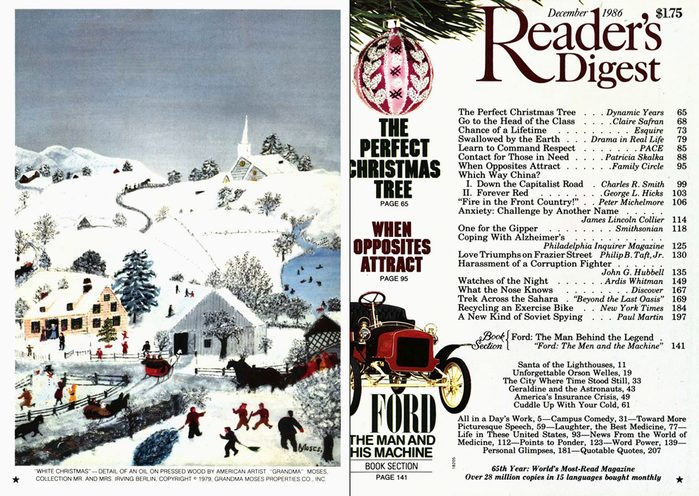
Readers were treated to a detail from “White Christmas” by Grandma Moses, the artist otherwise known as Anna Mary Robertson Moses.
November 1987
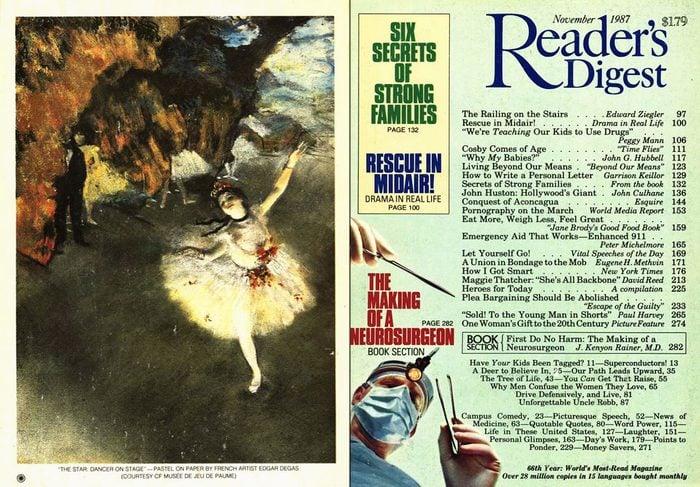
Readers who flipped the cover on this issue of the magazine were surprised by “The Star Dancer on Stage” by Edgar Degas.
March 1988
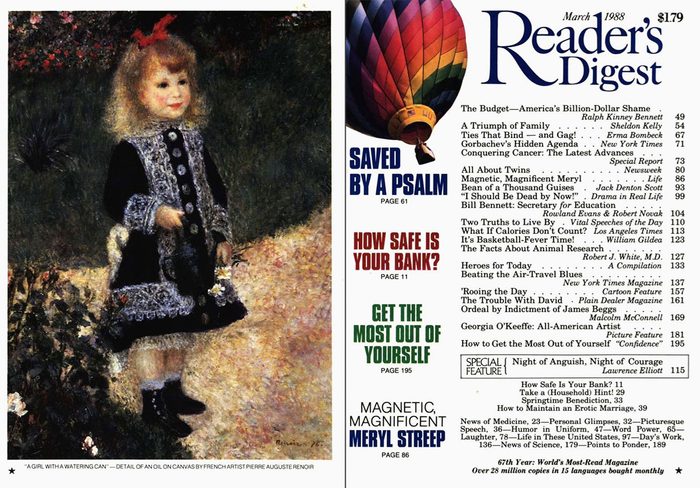
Pierre Auguste Renoir graced Reader’s Digest in 1988 with this detail from “A Girl With a Watering Can.”
August 1989
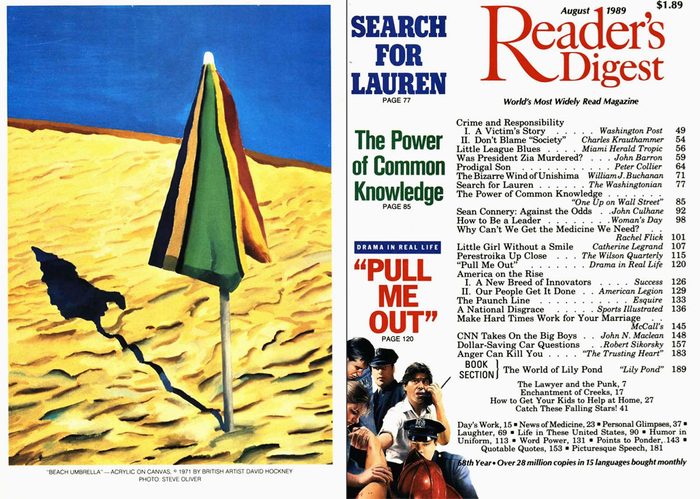
“Beach Umbrella” by the contemporary artist David Hockney served as the magazine’s back cover in the summer of 1989.
September 1991
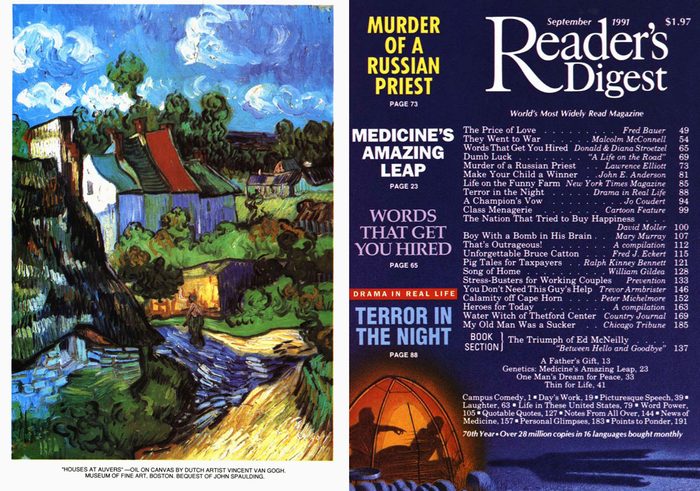
The magazine once again turned to Vincent van Gogh, with his “House at Auvers” serving as the September 1991 back cover.
October 1991
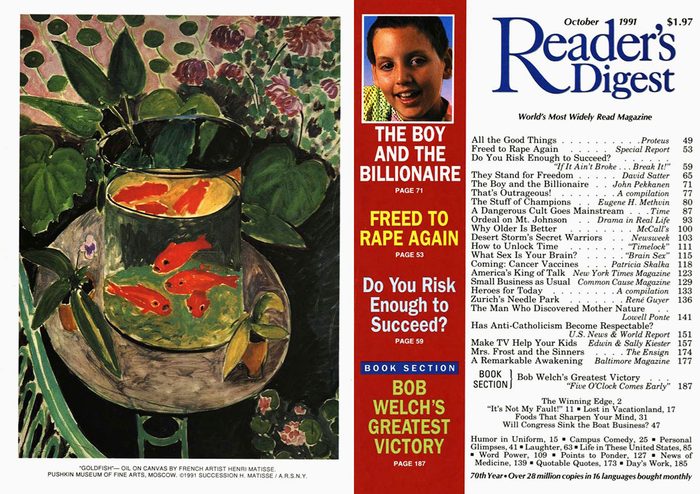
“Goldfish” by Henri Matisse was a back cover worthy of framing.
June 1996
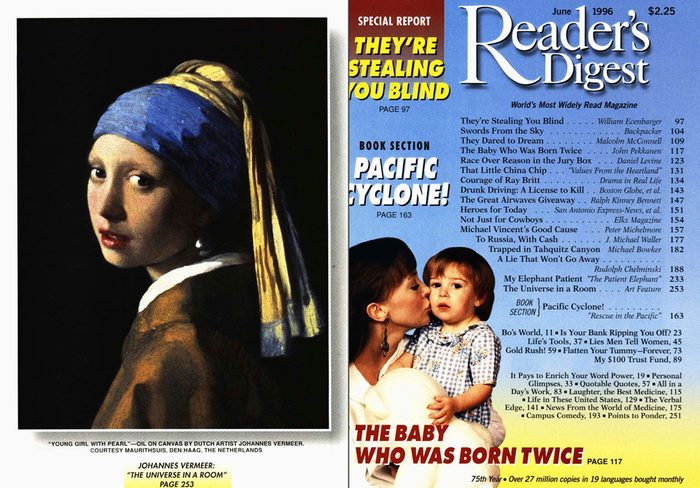
Johannes Vermeer’s “Young Girl With Pearl” earned the June 1996 cover slot. Another Vermeer painting earned the honor of being one of the most expensive things ever stolen.
November 1998
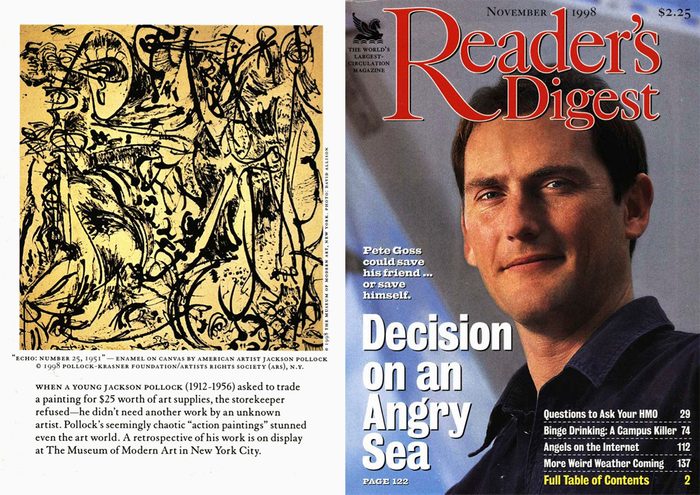
Jackson Pollock’s “Echo: Number 25, 1951” gave readers a taste of modern art.
February 1999
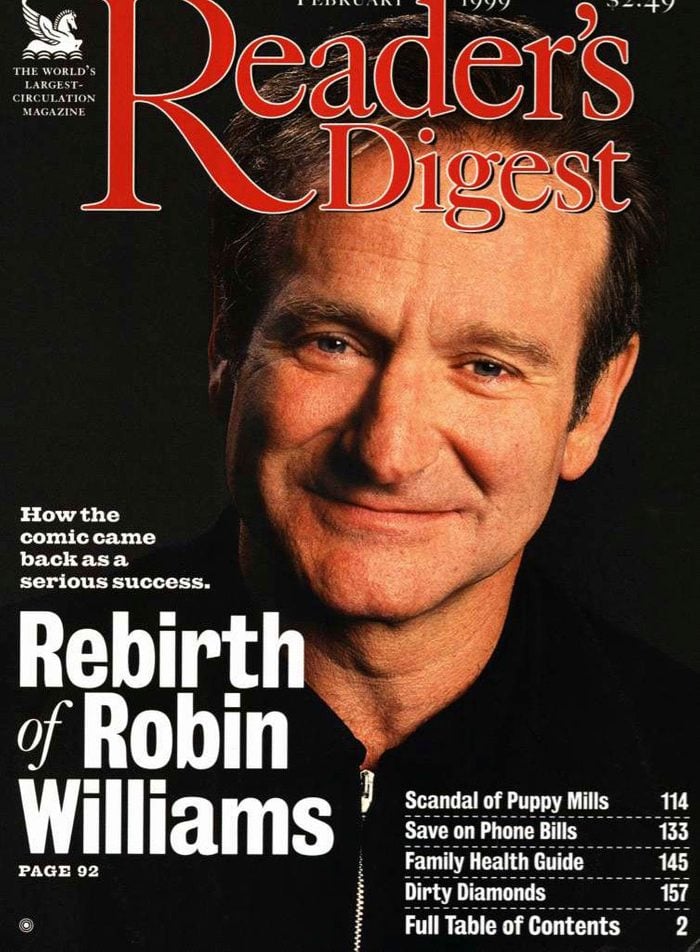
While Reader’s Digest has published countless articles by and about celebrities, starting with its very first issue, it rarely put them on the cover, as other major magazines did. In the 1990s, that began to change. Take, for instance, the February 1999 cover, which featured A-lister Robin Williams.
September 1999
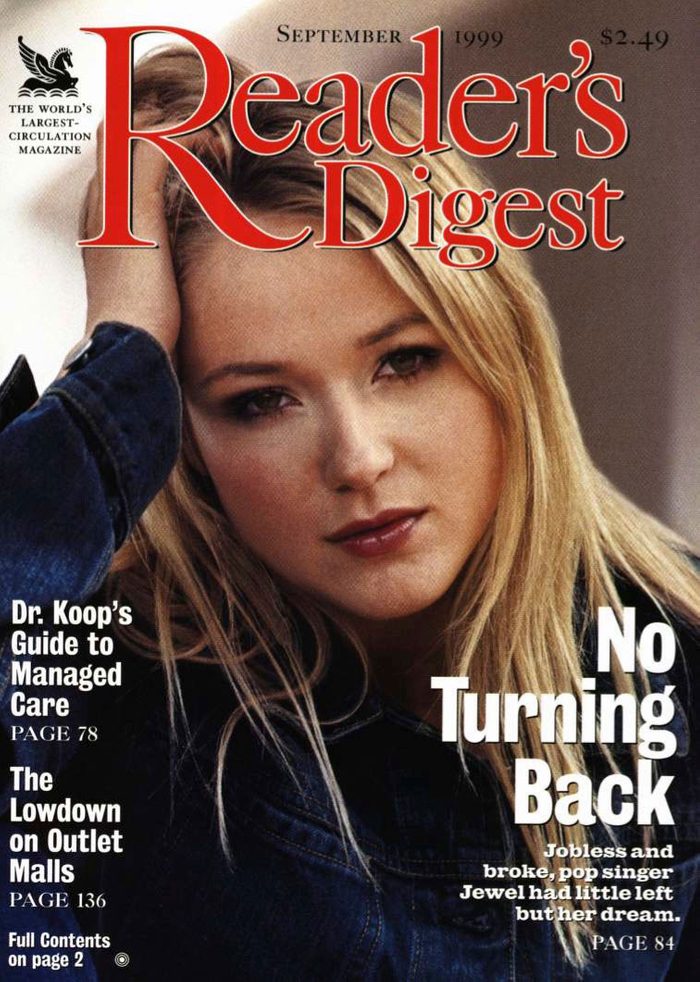
Singer and songwriter Jewel told her story in the September 1999 issue.
November 1999
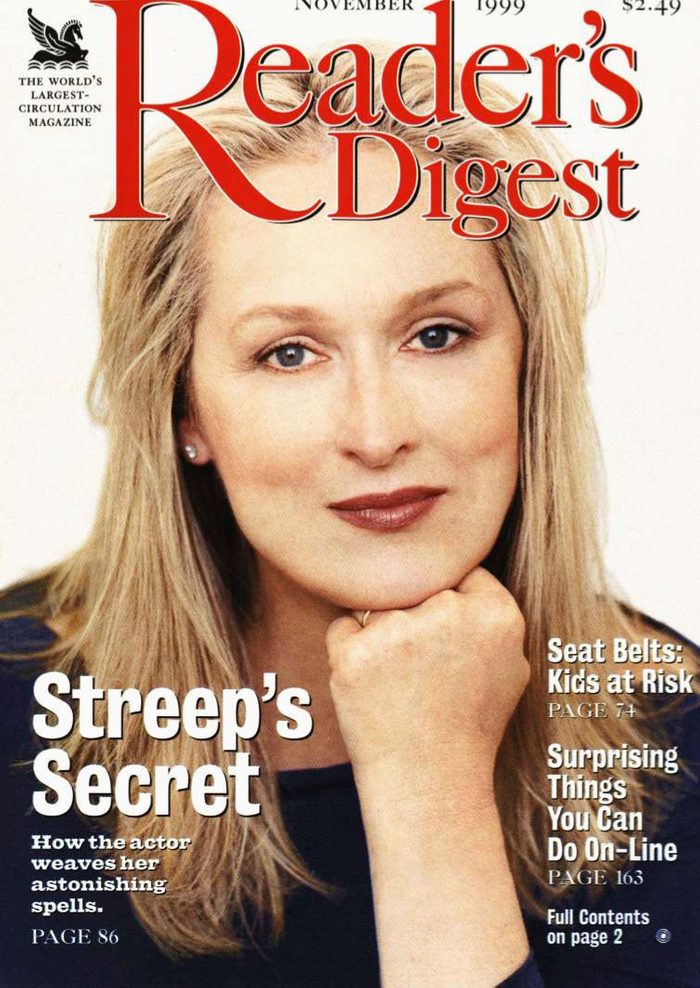
Actress Meryl Street revealed her acting secrets in November 1999.
December 1999
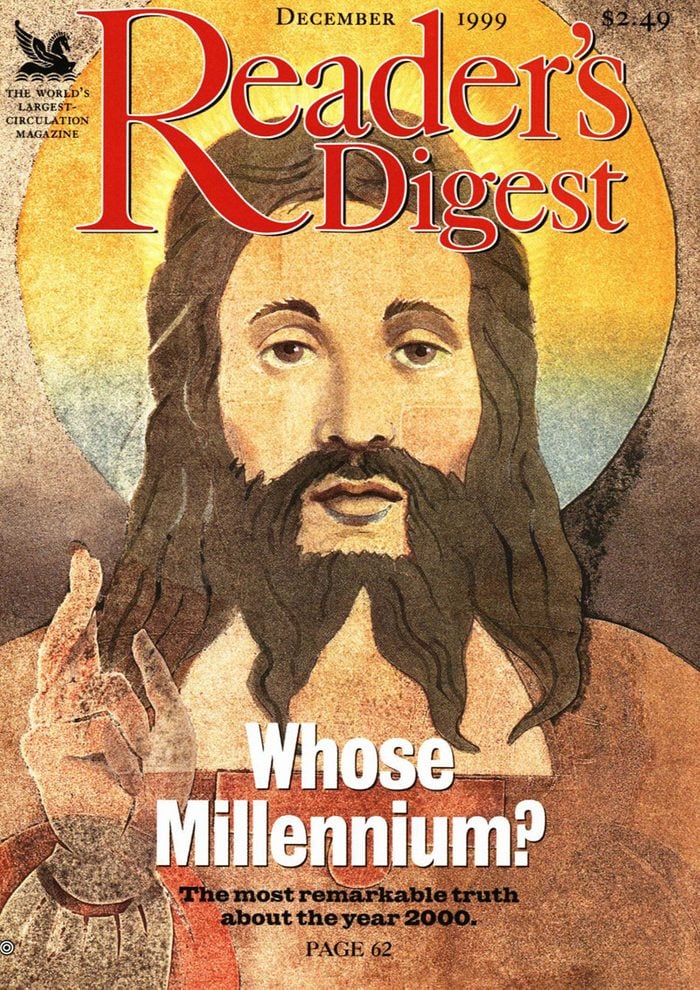
Reader’s Digest marked the coming millennium with its December 1999 cover.
November 2001

As Reader’s Digest entered the 21st century, the magazine continued to offer its readers timely advice on topics like staying healthy.
June 2002
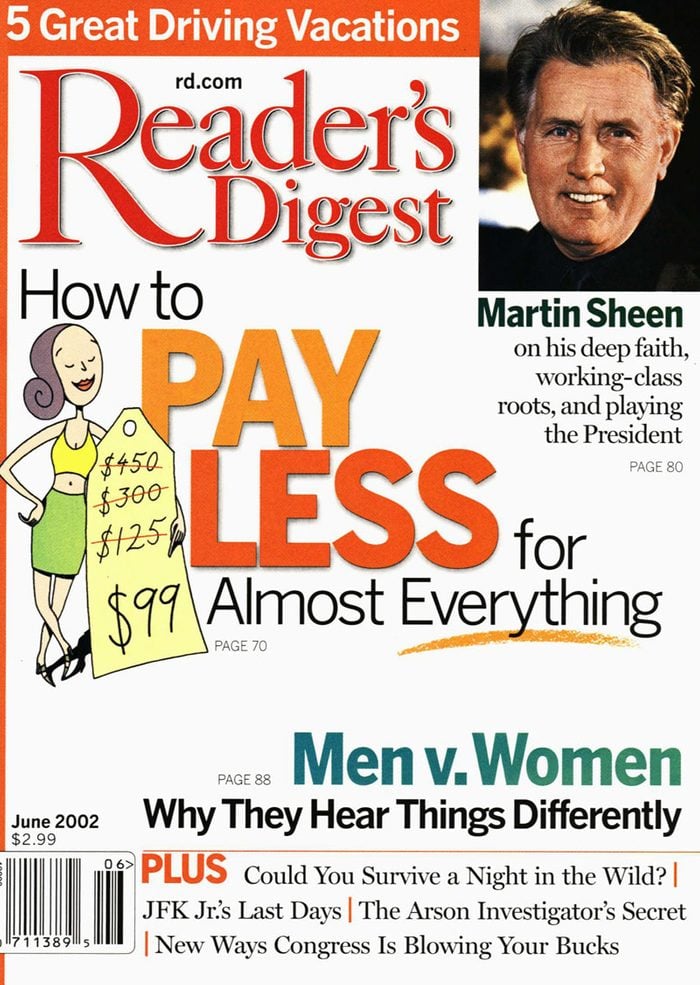
Managing money has also continued to be a popular topic. And Reader’s Digest is always there to offer up advice, like these ways you’re wasting money without knowing it.
September 2004

The magazine that taught the world that laughter is the best medicine continued to promote the healing power of humor. Enjoy these funny one-liners that will get you laughing.
December 2004
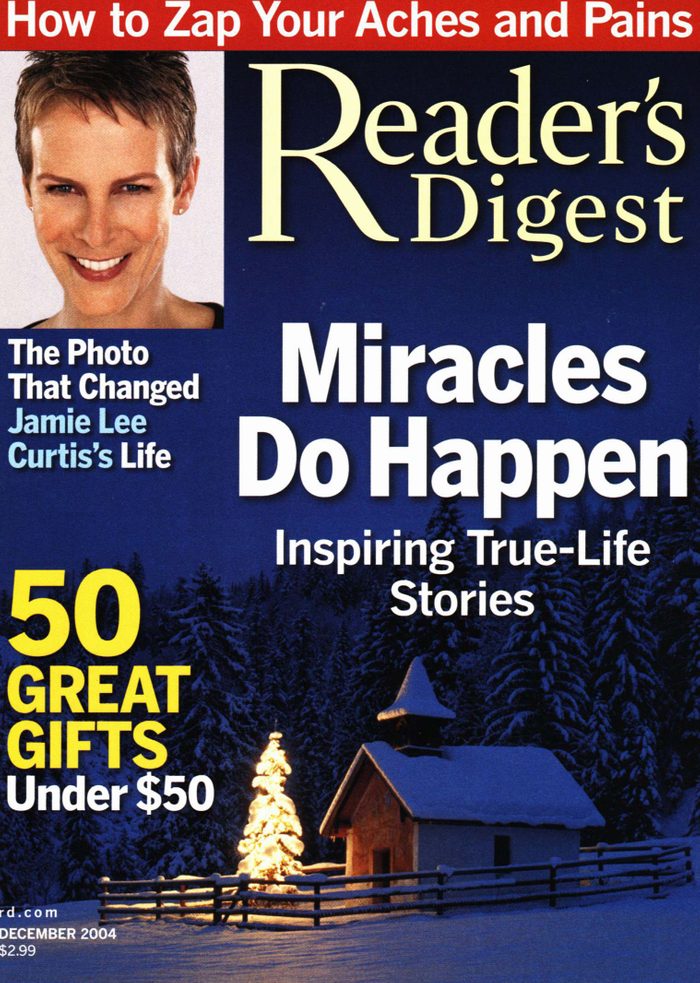
Inspiring real-life stories have also remained a staple of the magazine. Here’s a recent selection of our most inspirational stories.
August 2005
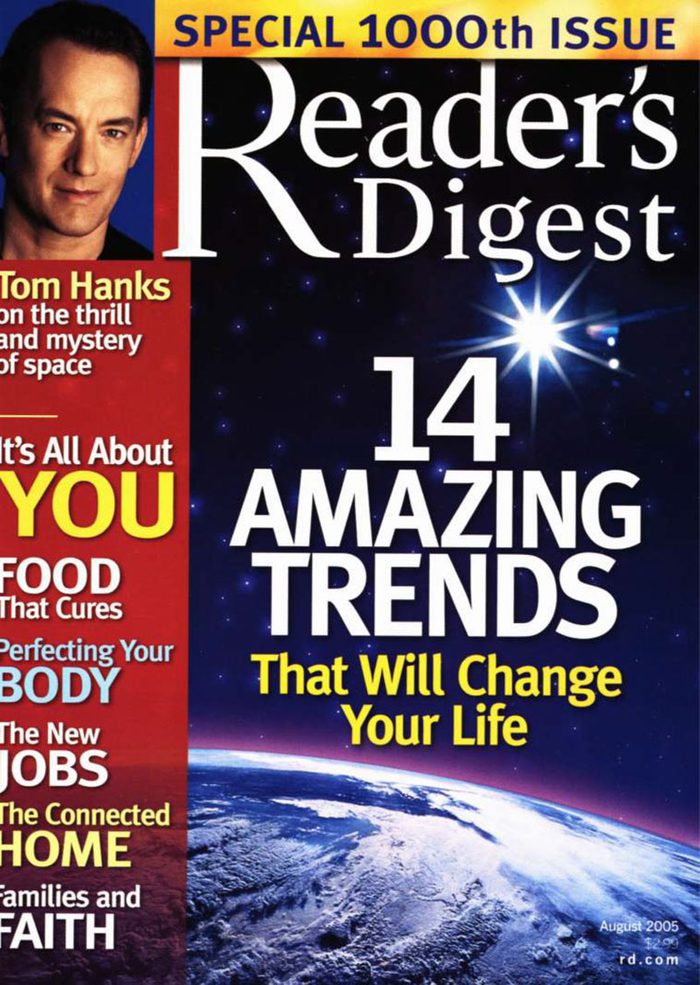
In 2005, Reader’s Digest reached another rare magazine milestone, publishing its 1,000th issue. That’s a whole lot of magazines!
June 2008

Smack dab in the middle of the Great Recession, the June 2008 issue aimed to help cash-strapped readers lower bills and get their finances in order.
July 2009

The patriotic themes that Reader’s Digest often evoked on its covers during the war years took on a lighter tone in the 21st century, as this and the next two covers illustrate.
June/July 2010
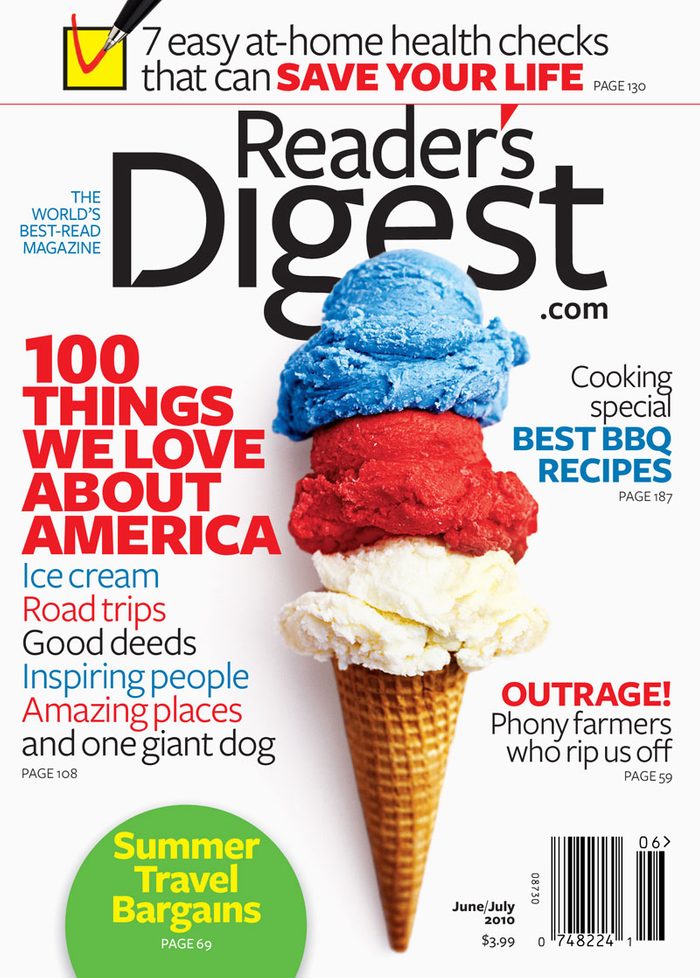
In a combined June and July issue, Reader’s Digest gave readers the scoop on “100 Things We Love About America.” Ice cream lovers will want to check out our list of the best ice cream shops in every state.
May 2011

The following year, the magazine got frank with readers about the “Best of America,” featuring over 100 people, places, and things to love. Here’s our guide to the best hot dog in every state.
September 2012

This 2012 cover promised Reader’s Digest readers the magazine’s “Funniest Issue Ever.” The baby seems to agree. Want more laughs? Try these short jokes on for size.